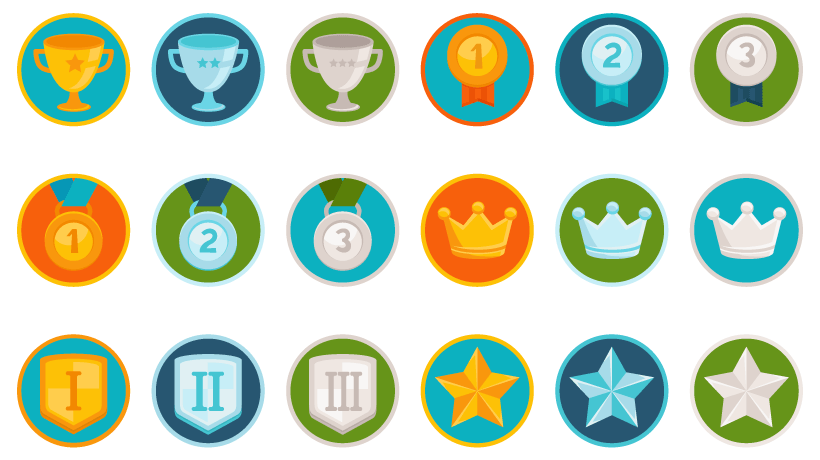Guide To Digital Badges: Their Many Functions And How To Implement Them Successfully
Just like their real-world counterparts, digital badges serve a wide variety of purposes depending on the issuing body and the individual. For the most part, badges’ functions can be bucketed into one of 5 categories:
1. Motivate Participation
This is one of the core functions, to encourage participation by recognizing individual participants. TripAdvisor’s issuing of digital badges to users were meant to recognize their most frequent contributors and encourage others to follow suit. Numerous organizations rely on badges boost participation in employee training and other HR programs.
2. Motivate Collaboration
Most online communities rely on a small number of individuals generating a majority of the content and discussion, which means fewer overall opinions. By using digital badges as rewards to encourage collaboration, a wider variety of voices and perspectives can be elicited, which can in turn help to engage more individuals in discussion or data-sharing. For example, OER Commons uses badges to encourage collaboration among teachers, educators, and more in their online community.
3. Recognition And Assessment
Digital badges can be used to recognize quality, indicate trust, or represent awards. In the education space they’re often associated with various types of assessments, including summative (evaluation of prior learning), formative (provide guidance and feedback), or transformative (reshape the learning process). Digital badges are most commonly associated with formative assessment where an individual is provided feedback and his or her progress is tracked. This is common with massive open online courses (MOOCs for short) and online assessments. Badges can also be strung together to show various “levels” of mastery obtained over time.
4. Alternative Credentials
Some consider badges a potential threat or challenger to diplomas given the fact that more and more online education programs are adopting badges to mark achievement. However, this notion is hotly contested. It’s more common for individuals and organizations to recognize the modular nature of badges versus the comprehensive nature of a diploma or degree. But again, this is up for debate.
5. Represent Competencies
In most educational programs, traditional time-based assessments provide a single quantitative grade, more often than not on some kind of “pass - fail” scale. Badges provide a more modular and flexible way of showing various levels and combinations of competency or mastery.
How Badges Are Issued And Verified
Badges are issued by individual organizations who set criteria for what constitutes earning a badge. They’re most often issued through an online credential or badging platform. These platforms allow organizations to design, issue, and manage the various badges they want to award to individuals.
Most advanced digital badging platforms offer integrations into Learning Management Systems (LMS for short) that automate the issuing process after a course or program is completed (and passed).
The actual issuing of a badge, in practice, is only one of many steps in what can be a much longer process. At a higher level that process may look as follows:
- Determine what skill or achievement to recognize.
- Set the criteria for what constitutes earning the badge.
- Develop test or course criteria/curriculum.
- Make the curriculum available to individuals (can be free or paid, online, or in person).
- Score or evaluate those who enroll in or complete the course, to determine who will receive the badge.
- Design and issue the badge via a digital credential platform.
As stated before, the purpose of this final step is to award a badge to serve as an indicator of accomplishment or skill that can be displayed, accessed, and verified online. And now that a badge has been issued to an individual, he or she can share it in various formats. These might include social media, personal websites, email signatures, professional profiles (ex: LinkedIn), and resumes.
The Importance of Sharing and Verification Individuals work to earn digital badges for a specific purpose. Sometimes that’s general self-improvement, but often it’s because they’re trying to show current or potential future employers that they are continuing to grow or have acquired new skills. This means 2 things:
- Individuals will want to share or display their digital badges.
- Third party “verifiers” will want to be able to verify the badge is legitimate.
If an individual can’t share their badge, and if a third party can’t verify it, then the value of the underlying credential is significantly diminished. This is one of the main reasons for the Open Badge standard. Third party verifiers can see the various meta-data associated with the badge to determine if it is valid. Again, these data include things like:
- What the badge is called.
- The name of the organization that issued the badge.
- What the badge represents.
- What an individual had to do to earn the badge.
- The name of the person who earned the badge.
- When the badge was issued and if it expires.

Example of Accredible’s new ability to verify the legitimacy of badges or certificates using the Blockchain. | Source: Accredible
The end goal is for a third party (such as a current or future employer) to be able to quickly and easily see what the badge represents and verify that it is legitimate.
Criticism Of Digital Badges
There are various arguments to be made against the implementation of digital badges. For example, some people argue that they may encourage hierarchical relationships when implemented online. Other times, badges are criticized for encouraging behavior that may be beneficial for the issuer but not necessarily the individual. Some claim that administering badges for things that people are doing or should be doing reduces people’s motivation to complete those tasks when the reward is removed.
Specifically in education, the “gamification” of earning badges raises concerns that students may start to obsesses about earning as many badges as possible instead of on mastering the right material, or that the badges offered may not even represent anything of value. The problem of “meaningless” badges is brought up often, especially when badges can be earned for simply signing up for a course or watching a video. This leads to the biggest criticism of badges, their perception as “low stakes,” or even worse, a claim that due to the frequency of their use as such that they fundamentally cannot be viewed as “trusted credentials.”
How do you know a badge is valid or credible? How do you know a badge was earned and not simply handed out for the passing of a trivially low bar? These are important questions to consider.
There are ways to address these criticisms, most commonly along the lines of requiring that embedded records of who issued the badge are supported by links to pages explaining in detail how and why the recipient earned it, and providing further details regarding their program. This can mitigate some concerns, but the debate will undoubtedly continue.
The Future Of Digital Badges
With the rise of online education and the increasing availability of high quality massive open online courses, more and more individuals will choose to learn new skills outside of traditional colleges and universities. This is not to say that traditional methods of learning will go by the wayside. It simply means that a college or university diploma is no longer the only credential that can be used to evaluate the competency of an individual.
This does mean, however, that third party verifiers (re: employers) will demand that they can evaluate the quality of an individual’s achievement in the same way they were able to when evaluating a traditional diploma. In short, there will be an increasing need for verifiable digital badges and digital credentials in the coming years.
Look for 3 things from badges in the not-so-distant future:
- Badges will continue to gain popularity as a way to signify learning achievement.
- The need to verify the legitimacy of badges will increase as more organizations enter the market and offer their own online courses.
- More and more employers will rely on badges and other forms of digital credentials when making hiring decisions.
If you want to know more about digital badges, download the free eBook A Comprehensive Guide To Digital Badges.
Related Articles:
- Free eBook: A Comprehensive Guide To Digital Badges
- How The Bitcoin Blockchain Is Impacting The eLearning Industry
- Digital Badges: What Are They And How Are They Used?









